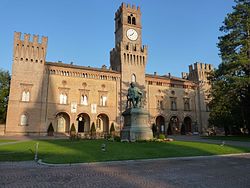Busseto
Comune in Emilia-Romagna, Italy From Wikipedia, the free encyclopedia
Comune in Emilia-Romagna, Italy From Wikipedia, the free encyclopedia
Busseto (Bussetano: Büsé; Parmigiano: Busèjj) is a comune in the province of Parma, in Emilia-Romagna in Northern Italy with about 6,763[2] inhabitants. Its history is quite well documented back to the 10th century, and for almost five hundred years it was the capital of Stato Pallavicino, which eventually became part of the Duchy of Parma.[5] The town is about 8 kilometres (5.0 mi) south of Cremona in Lombardy.
Busseto | |
|---|---|
| Comune di Busseto | |
 The Rocca Pallavicino in Busseto | |
| Coordinates: 44°58′51″N 10°02′33″E | |
| Country | Italy |
| Region | Emilia-Romagna |
| Province | Parma (PR) |
| Frazioni | Contrada della Chiesa, Frescarolo, Madonna Prati, Le Roncole, Samboseto, San Rocco, Sant'Andrea, Semoriva, Spigarolo |
| Government | |
| • Mayor | Maria Giovanna Gambazza |
| Area | |
| • Total | 76 km2 (29 sq mi) |
| Population | |
| • Total | 6,763 |
| • Density | 89/km2 (230/sq mi) |
| Demonym | Bussetani |
| Time zone | UTC+1 (CET) |
| • Summer (DST) | UTC+2 (CEST) |
| Postal code | 43011 |
| Dialing code | 0524 |
| Website | Official website |
The first written sources give the name as "Buxetum" in the early twelfth century. As such it appears the town's name is cognate with:
The town hosts La Rocca, on the site of the founding fortress of Adalberto Pallavicini, scion of his family, in the eleventh century. In the first half of the thirteenth century, it was laid out afresh to figure a moat and a drawbridge facing the square. Successive damage which lost the drawbridge and parts of the walls was followed by alterations and partial rebuilding. In 1857 its bulk was rebuilt almost entirely in neo-Gothic style – under theatre architect Pier Luigi Montecchini (b.1822, d. 1887). Its present form has preserved the 13th century keep and the main tower. La Rocca, within which lies the Teatro Verdi, it is now the Municipal Palace, the seat of the municipality of Busseto.
Opera composer Giuseppe Verdi was born in the nearby village of Le Roncole in 1813 and he moved to the town in 1824. Other figures from the world of opera are associated with the town: until his death, retired tenor Carlo Bergonzi owned the hotel I due Foscari, which also hosts the Accademia Verdiana. Bass-baritone Luca Pisaroni grew up there from the age of four after his family moved to Busseto in 1979, where his father owned a car-repair firm and his mother was a teacher.[6] It was in that town where, he noted, "you feel Verdi's spirit all over the place!"[7] and where his love of opera began. Italian journalist Giovannino Guareschi also lived in Le Roncole, and his Mondo Piccolo is set there.



In the town and locally many sites linked to the life of Verdi can be visited. These include:
The nearby village of Le Roncole was Verdi's birthplace on 10 October 1813. The house has been a national monument since 1901.[8]
Close by the main square is the home of Antonio Barezzi, the man who supported his early endeavours. He became Verdi's patron and his father-in-law. In the upstairs lounge, the young Verdi gave his first public performance in 1830 and continued to frequent the house until the death of his benefactor.
The first portrait of Verdi and an oil depicting Antonio are on display in the house. Verdi's letters are displayed. This house is the headquarters of the Friends of Verdi; the organization oversaw the restoration of the building in 1979 and 1998. Since 2001, there has been a permanent exhibition of objects and documents related to Verdi and his relationship to the Barezzis.
These two of Busseto's ten churches (chiese) were where Verdi played the organ. Santa Maria degli Angeli has its own article as does San_Michele_Arcangelo, Busseto.
This is the large, ornate house which Verdi bought in 1845.[9] He lived there with Giuseppina Strepponi, not yet his wife, from 1849 to 1851. Verdi composed Luisa Miller, Stiffelio and Rigoletto while living there.[10]
The Teatro Giuseppe Verdi is a small 300-seat theatre built by the municipality without Verdi's prior approval however he donated towards its completion.
The National Museum of Giuseppe Verdi is housed at the Renaissance Villa Pallavicino;[11] it was inaugurated on 10, October 2009, the 196th anniversary of the composer's birth.
In the nearby village of Sant'Agata, in the province of Piacenza, is the Villa Verdi, the house which he commissioned in 1848 while living in Busseto and where his parents lived until 1851, after which it became Verdi's main home for the rest of his life. He lived there less frequently after the death of his wife, Giuseppina, in 1897.[12]
Busseto has a railway station on the Cremona–Fidenza line.
Friendship city: Sarasota, Florida, US
Seamless Wikipedia browsing. On steroids.
Every time you click a link to Wikipedia, Wiktionary or Wikiquote in your browser's search results, it will show the modern Wikiwand interface.
Wikiwand extension is a five stars, simple, with minimum permission required to keep your browsing private, safe and transparent.